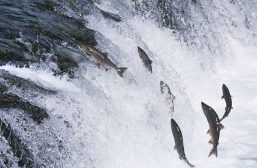Definition
noun, plural: Actinopterygians
Any of a group of Osteichthyes characterized by possessing lepidotrichia (i.e. fin rays) as opposed to the lobe-finned fish
Supplement
Osteichthyes is taxonomic superclass of the phylum Chordata (chordates) and includes groups of fish that have skeletons mainly composed of bone tissues. This superclass includes the ray-finned fish (actinopterygians) and lobe-finned fish (sarcopterygians). The ray-finned fish belongs to the taxonomic class Actinopterygii (i.e. Latin actino-, meaning “having rays” and Greek ptérux, meaning “wing, fins”).
The actinopterygians are distinctive from the other group of Osteichthyes, i.e. the sarcopterygians or the lobe-finned fish. These two groups are distinguished based on their fins. The actinopterygians have distinct ray fins whereas the sarcopterygians have fleshy, lobed fins. The fins of the actinopterygians are webs of skin supported by spines that are generally stiff and sharp.
The actinopterygians are the most ubiquitous fish species in aquatic habitats. They constitute nearly 99% of over 30,000 fish species. There are two subclasses: (1) Chondrostei and (2) Neopterygii (further divided into infraclasses Holostei and Teleostei).
Examples of actinopterygians are tuna, swordfish, salmon, cod, catfish, flatfish, sturgeon, lanternfish, fangtooth, anglerfish, sea horses, lion fish, tiger fish, etc.
Scientific classification:
- Kingdom: Animalia
- Phylum: Chordata
- Superclass: Osteichthyes
- Class: Actinopterygii Klein, 1885
Synonym(s):
See also:
- Osteichthyes
- sarcopterygian







